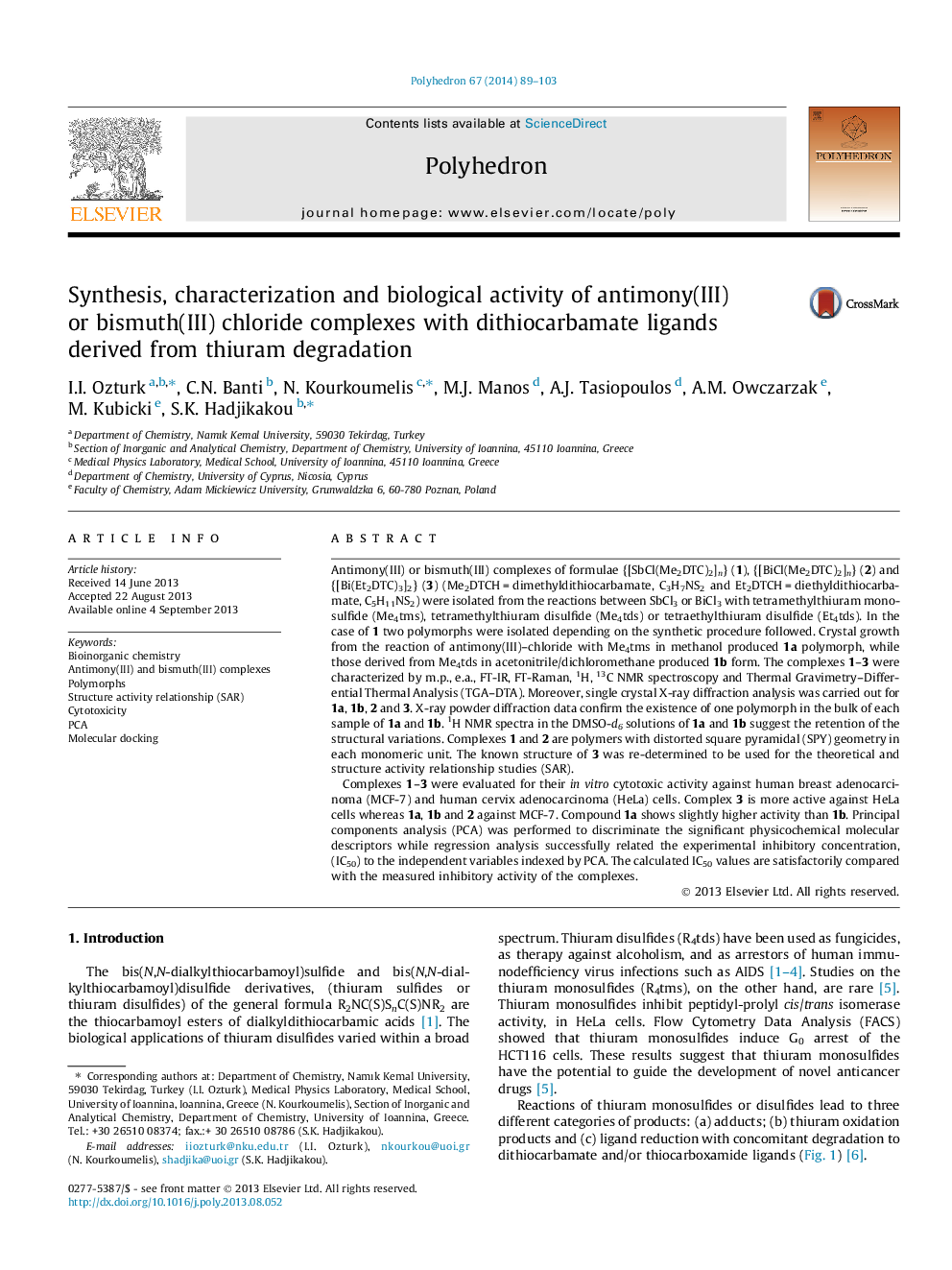| کد مقاله | کد نشریه | سال انتشار | مقاله انگلیسی | نسخه تمام متن |
|---|---|---|---|---|
| 1335458 | 1500272 | 2014 | 15 صفحه PDF | دانلود رایگان |

Antimony(III) or bismuth(III) complexes of formulae {[SbCl(Me2DTC)2]n} (1), {[BiCl(Me2DTC)2]n} (2) and {[Bi(Et2DTC)3]2} (3) (Me2DTCH = dimethyldithiocarbamate, C3H7NS2 and Et2DTCH = diethyldithiocarbamate, C5H11NS2) were isolated from the reactions between SbCl3 or BiCl3 with tetramethylthiuram monosulfide (Me4tms), tetramethylthiuram disulfide (Me4tds) or tetraethylthiuram disulfide (Et4tds). In the case of 1 two polymorphs were isolated depending on the synthetic procedure followed. Crystal growth from the reaction of antimony(III)–chloride with Me4tms in methanol produced 1a polymorph, while those derived from Me4tds in acetonitrile/dichloromethane produced 1b form. The complexes 1–3 were characterized by m.p., e.a., FT-IR, FT-Raman, 1H, 13C NMR spectroscopy and Thermal Gravimetry–Differential Thermal Analysis (TGA–DTA). Moreover, single crystal X-ray diffraction analysis was carried out for 1a, 1b, 2 and 3. X-ray powder diffraction data confirm the existence of one polymorph in the bulk of each sample of 1a and 1b. 1H NMR spectra in the DMSO-d6 solutions of 1a and 1b suggest the retention of the structural variations. Complexes 1 and 2 are polymers with distorted square pyramidal (SPY) geometry in each monomeric unit. The known structure of 3 was re-determined to be used for the theoretical and structure activity relationship studies (SAR).Complexes 1–3 were evaluated for their in vitro cytotoxic activity against human breast adenocarcinoma (MCF-7) and human cervix adenocarcinoma (HeLa) cells. Complex 3 is more active against HeLa cells whereas 1a, 1b and 2 against MCF-7. Compound 1a shows slightly higher activity than 1b. Principal components analysis (PCA) was performed to discriminate the significant physicochemical molecular descriptors while regression analysis successfully related the experimental inhibitory concentration, (IC50) to the independent variables indexed by PCA. The calculated IC50 values are satisfactorily compared with the measured inhibitory activity of the complexes.
Three new antimony(III) or bismuth(III) chloride complexes (1–3) with dithiocarbamates derived from thiuram degradation were synthesized. Two polymorphs were isolated, in case of 1, (1a and 1b) depending on the preparation procedure followed. Complex 3 is more active against HeLa, while 1a, 1b and 2 are more active against MCF-7 cells. Molecular docking studies explained the experimental IC50 values in terms of the known ligand binding domains of ER (1A52) while PLS analysis with only three latent components constructed a linear theoretical model which effectively predicts the experimental inhibitory activity of the complexes.Figure optionsDownload as PowerPoint slide
Journal: Polyhedron - Volume 67, 8 January 2014, Pages 89–103